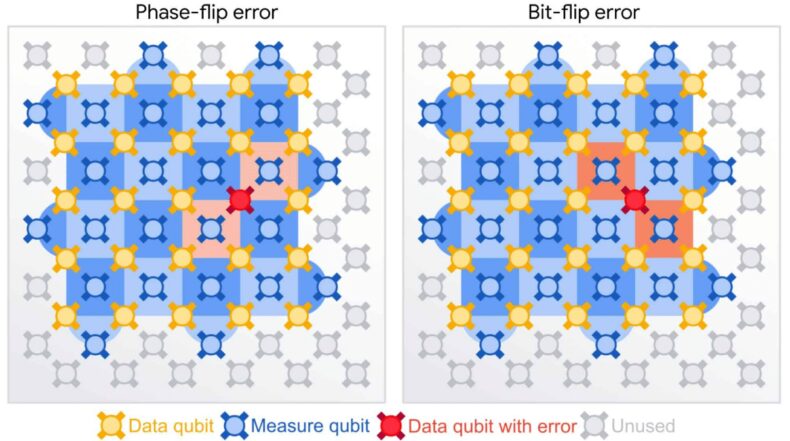Table of Contents
Quantum Error Correction is an important hurdle that needs to be cleared to achieve building large-scale Quantum Computers that solve real-world problems. Recently, Researchers at Google’s Quantum AI have shown a breakthrough in decreasing Quantum Error rates that brings us a step closer to building error-tolerant Quantum Computers, by adding more and more Quantum Bits (QUBITS) that are used in a Quantum Computer to work on Error Correction.
Quantum Computers hold great regard in Technology because of their capability to revolutionize the way we handle and solve complex problems with their help. This could only be achieved only if we are capable of building large-scale Quantum PCs with a huge number of QUBITS placed in a Quantum Computer. But handling such a huge number of QUBITS is very hard due to their complex nature and very high sensitivity, the Information they hold can be destroyed very easily which leads to an increase in error rates in Quantum Computers.
Google Quantum AI has made a breakthrough by using a method called surface code scheme. when a group of QUBITS is encoded with a bit of information to act as a single QUABIT it is called a logical QUBIT, when information is encoded into an array of Logical Qubits it is called a Surface Code.
Quantum Error Correction
Physicists believe that to achieve a Large scale Quantum Computer it is important to achieve an error rate of one in a million QUBITS. But as of now many Quantum Computers have an error rate of one in a thousand. But, as mentioned above, Google’s Quantum AI with its research in Surface Code Schemes has taken an important step to achieve the required Error Rates.
Bit Flip and Phase Flip are two types of errors that occur in QUBITS that are used to store information in a Quantum Computer. Google’s Quantum Processor Consists of Superconducting QUBITS that are used either as data QUBITS for processor operations or measurement QUBITS that lie adjacent to data QUBITS which can measure the two types of errors, Bit Flip and Phase Flip.
Google’s Quantum AI has made modifications to this basic design to increase the ability of their Quantum Computer to decrease Error Rates. They did this by using highly advanced fabrication methods to build QUBITS, to reduce the error rates of an individual Quantum BIT. They also increased the dephasing lifetime. They have also improved other operational protocols such as performing fast, repetitive measurements and leakage reset where leakage refers to the unwanted transition of a QUBIT into a quantum state that is not used in computations.

This image is an illustration of how Phase Flip and Bit Flip error correction works. The Measure QUBITS on Light blue background measure Phase Flip Errors while the Measure QUBITS on a dark blue background measure the Bit Flip Errors and the QUBITS marked in red in the above illustration are the QUBITS that are showing errors. Check: 1st Health Care Quantum Computer
Google’s Quantum AI has tested their scalability from their research by comparing their ‘ Distance 3 array’ logical qubit and ‘Distance 5 array’ logical qubit and the ‘ Distance 5 array’ has outperformed the other by a decrease in error rate. The distance 3 array had an error rate of 3.028% and the Distance 5 array had an error rate of 2.914%. This shows that error rates can be reduced by increasing the QUBIT arrays which is an important achievement and shows that this can be a viable path to building Error-Tolerant Quantum Computers.
The Director of Google’s Quantum AI has said that this research and the results it yielded were “absolutely critical” for building a Fault Tolerant Large Scale Quantum Computer, she also said that this experiment is something that every hardware platform and organization should pass to scale their systems.













